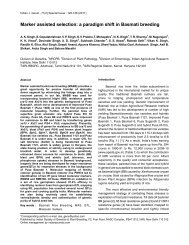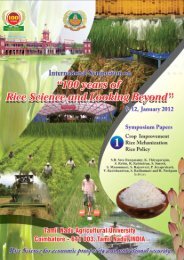Abstracts
Abstracts
Abstracts
- No tags were found...
You also want an ePaper? Increase the reach of your titles
YUMPU automatically turns print PDFs into web optimized ePapers that Google loves.
National Seminaron''Contemporary Approachesto Crop l111provement''April 22·23, 2011atUAS, BangaloreOrganized byIndian Society of Genetics and Plant Breeding (ISGPBJNASC Complex, Post Box I 11312, IARI, New Delhi 110 012Indian Council of Agricultural ResearchNew Delhi 110 114andUniversity of Agricultural SciencesGKVK Campus, Bangalore 560 065Book of<strong>Abstracts</strong>
National Seminar on “Contemporary Approaches to Crop Improvement” 7Marker assisted selection: a paradigm shift in Basmati breedingA.K. Singh, S. Gopalakrishnan, K.V. Prabhu, T. Mohapatra, N.K. Singh, T.R. Sharma, M. Nagarajan,K.K. Vinod, Devinder Singh, U.D. Singh, Subhash Chander, Vikas K. Singh, Ranjith K. Ellur, AtulSingh, Deepti Anand, Apurna Khanna, Sheel Yadav, Nitika Goel, Ashutosh K. Singh, Asif B. Shiakri,Anita Singh and Balram MarathiDivision of Genetics, IARI, New Delhi-110012; aks_gene@yahoo.comBasmati rice from the Indian subcontinent is highly priced in the international market forits unique quality. The traditional Basmati cultivars are tall, prone to lodging, photoperiodand temperature sensitive and very low yielding. Genetic improvement of Basmati rice at IARI hasled to development of a number of high yielding Basmati rice varieties, wherein the duration ofTraditional Basmati rice varieties has been reduced from 160 days to 115-140 days withenhancement of productivity from 2.5 tons/ha to 6-8 tons/ha. Country’s forex earning from exportof Basmati rice has gone up from Rs. 294 crores in 1990-91 to Rs. 12,000 crores in 2009-10, towhich the contribution of IARI varieties is more than 60 per cent. Basmati rice varieties in generalare susceptible to several biotic stresses such as bacterial blight (BB), blast and brown plant hopper(BPH). A number of genes conferring resistance to these biotic stresses have been identified andmapped with tightly linked molecular markers. However, all these genes are available in non-Basmati sources and their transfer to Basmati background impairs the grain and cooking qualitytraits of Basmati rice varieties. Under these circumstances, marker assisted backcross breeding(MABB) provides a great opportunity for precise transfer of desirable donor segment whileminimizing the linkage drag. Thus integration of molecular breeding approaches furtherenhances the efficacy of Basmati breeding programme. Development and release of ImprovedPusa Basmati 1 in 2007, developed by marker assisted pyramiding of genes xa13 and Xa21 forresistance to BB in the background of Pusa Basmati1, is a landmark. Currently we are usingMABB for transferring genes for resistance to BB (xa13 and Xa21), blast (Piz5 and Pikh) and BPH(Bph 3, Bph 13, Bph 18, Bph20 and Bph 21) into Basmati rice varieties Pusa Basmati 1121 and PusaBasmati 6. The parental lines of superfine grain aromatic rice hybrid Pusa RH 10 namely, Pusa 6A,Pusa 6B and PRR 78 have already been improved for resistance to BB and blast by transferringgenes xa13+ Xa21 and Pikh +Piz5, respectively. In addition, a major QTL for salt tolerance (Saltol)is being transferred to Pusa Basmati 1121, which is widely grown in Haryana, the state havingproblem of salinity owing to underground brackish water. In order to develop genetically enhanceddonor sources for resistance to biotic (BB, blast and BPH) and abiotic (Salt tolerance, droughttolerance and phosphorus uptake) stresses in Basmati background, we are developing isogenic linesfor major resistance genes/QTLs for respective stresses in the background of Pusa Basmati 1, thefirst semi-dwarf high yielding Basmati rice variety, developed by IARI. Further, QTL mappingusing RIL population has resulted in identification of several novel QTLs for grain and cookingquality traits. Molecular markers are also being used in routine for establishing variety/hybridsidentity and authentication of genetic purity of hybrid seed lots.
National Seminar on “Contemporary Approaches to Crop Improvement” 127PS-II: 74Genetic survey of Pup1 gene among aromatic and non-aromatic ricegermplasm using gene based markersRanjith K Ellur, K. K. Vinod 1 , Sheel Yadav, Ashutosh Singh, Deepti Anand, M. Nagarajan 1and A. K. SinghDivision of Genetics, Indian Agricultural Research Institute, New Delhi 1100121 IARI - Rice Breeding and Genetics Research Centre, AduthuraiPhosphorous (P), an essential element required for the constitution of cellular components,including nucleic acids, membranes and ATP, is a key component for the regulation of manyenzymatic reactions and in signal transduction processes of the plant system. The clay particlesbeing negatively charged most of the P is leached out from the soil and the remaining P is eitherconverted to organic compounds by microorganisms or becomes insoluble by interacting withcations making them unavailable to plant. Therefore, agriculture demands heavy applications ofP containing fertilizers. In concern with the economical as well as ecological point of view, inthe era of transcending towards organic agriculture, development of rice varieties that can extractP from P-fixing soils with higher P fertilizer use efficiency is considered an important breedinggoal. Pup1 (Phosphorous uptake 1) was reported as the major QTL conferring tolerance to the Pdeficiency under field conditions. The Pup1 locus is reported to be a complex locus, probablyharbouring many uncharacterized genes, and is ~130kb long. It is known to be present more inindicas than in japonicas, especially among upland varieties of both the sub-types. Gene basedmolecular markers for this major QTL has already been developed. In the current study, 105 ricevarieties, including major basmati varieties, were screened using reported gene based markersK29, K46, K59 and K41 spanning the Pup1 locus with Vandana as positive, N22 as partial, IR64and Anjali as negative checks. Twenty three varieties (22%), most of them non-aromatic, weredevoid of Pup1 locus. Only one aromatic line Pusa 1176, has showed marked absence of Pup1 inthis study. Forty-three varieties showed presence for all markers tested, while the remainingexhibited partial presence of Pup1 locus. Partial presence of the alleles among many of the testedlines could be due to recombination within this locus. A sub-set of the genotypes from all thegroups were evaluated under hydroponic conditions, under restricted P nutrition. A markeddifference among genotypes in root system development was reported in hydroponic screeningof Pup1 positive genotypes.
138 Book of <strong>Abstracts</strong>PSII: 88Development of near isogenic lines for major blast resistance gene(s) inthe background of a Basmati rice variety Pusa Basmati-1Apurva Khanna, Vinay K. Sharma * , Smriti Guleria, S. Gopalakrishnan, M. Nagarajan, K.K.Vinod, U.D. Singh, T.R. Sharma + and A.K. SinghDivision of Genetics, IARI, New Delhi-110012*Professor and Dean, Division of Biosciences and Biotechnology, Banasthali University, Banasthali,Rajasthan+Principal Scientist, NRCPB, IARI, New Delhi-110012; khannaapurva@gmail.comBasmati is the prized possession of the country’s culture and hall mark for rice trade in worldmarket. Blast disease is major constraint limiting basmati rice productivity in irrigated as well asupland rice ecologies in India, causing an annual loss of 10-30% in rice production. Basmati ricevarieties in general are highly susceptible to blast disease and there is no resistance sourceagainst this pathogen available in the Basmati rice germplasm. Therefore, transferring the blastresistance genes from the non-Basmati donors to Basmati rice varieties becomes necessary fordeveloping stable blast resistant basmati rice varieties. However, use of non-Basmati donors inBasmati breeding program impairs the grain and cooking quality of Basmati rice varieties.Therefore, having major blast resistance genes in the background of a Basmati rice variety wouldmake a valuable genetic resource for use in Basmati breeding. Here we report development ofisogenic lines carrying four major blast resistance genes (Pi5, Pib, Pi9 anf Piz-5)in the geneticbackground of a widely grown Basmati rice variety Pusa Basmati 1, using marker assisted backcross breeding (MABB). The lines of IRBL series were used as the blast resistant donors(IRBL5-M: Pi-5; IRBLb-B: Pib; IRBL9-W: Pi9 and IRBLz5-CA: Piz-5). Marker assistedforeground and background selection coupled with phenotypic selection was used as thebreeding strategy to hasten the breeding program. The tightly linked molecular markers AP4007,RM208, S04G03 and AP5930 for the genes Piz-5, Pib, Pi5, Pi9, respectively were used in theforeground selection. BC 2 F 1 s for the genes (Piz-5, Pib) and BC 3 F 1 generations for (Pi5, Pi9)have been grown at RBGRC, Aduthurai Tamil Nadu in the Rabi season of 2010-11. TheBackground analysis of the two BC 2 F 1 plants namely Pusa1636 (PB-1+Pi5) and Pusa1637 (PB-1+Pi9) carried out using 42 and 48 genome wide polymorphic STMS markers, has shown 88.7and 93.7% of the recurrent parent genome recovery (RPG), respectively. Data for agronomic,grain and cooking quality traits of selected various backcross generations plants show similarityof near isogenic lines under development with recurrent parent, Pusa Basmati 1.
212Book of <strong>Abstracts</strong>SA: 89Multi-environment evaluation of elite rice breeding lines derived fromSamba MashuriM. Nagarajan 1 , K K Vinod 1 , A K Singh 2 , Anil Kumar 3 , I S Solanki 3 , K V Prabhu 21 Rice Breeding & Genetics Research Centre, Indian Agricultural Research Institute, Aduthurai2 Division of Genetics, Indian Agricultural Research Institute, New Delhi 1101023 IARI Regional Station, Indian Agricultural Research Institute, Pusa, Bihar, kkvinodh@gmail.comA multi-environment evaluation trial (MET) for genotype performance is an essentialrequirement in cultivar development and pre-breeding. A set of eight elite breeding lines viz.,Pusa 5001-1-1-1, Pusa 5001-2-1-2, Pusa 5001-3-2-1, Pusa 5001-4-2-2, Pusa 5001-5-3-1, Pusa
National Seminar on “Contemporary Approaches to Crop Improvement” 2135001-6-3-2, Pusa 5001-7-3-3 and Pusa 5001-8-3-4 derived from a cross between Samba Mashuri(BPT5204) and IET18674 were evaluated in a MET in three locations across the country,Aduthurai in Tamil Nadu, New Delhi and Pusa in Bihar during kharif 2010 season. SambaMashuri (BPT5204) is a fine grain rice variety of 150 days duration. This variety is highlypopular among farmers despite of its susceptibility to few pests and diseases. IET18764 for is ahigh quality short grain aromatic breeding line. All of the eight elite selections were highyielding than BPT5204, and possessed high grain quality, and resistance. A. Significant variationwas observed among the breeding lines in yield, in all the locations, while they have showninsignificant variation with respect to days to 50% flowering. Among the lines Pusa5001-7-3-3showed good performance in all locations with highest yield in Aduthurai and New Delhi.Pusa5001-6-3-2, the next best performer in Aduthurai was also found yielding well in Bihar.Two line Pusa5001-5-3-1 and Pusa5001-8-3-4 performed well under New Delhi and Aduthuraisituations. Certain lines showed location specific performance, as seen in the case of Pusa5001-4-2-1 and Pusa5001-3-2-1 which performed well under Bihar situations. The results indicate thatamong the advanced selections, there are lines showing wider as well as specific adaptations.





